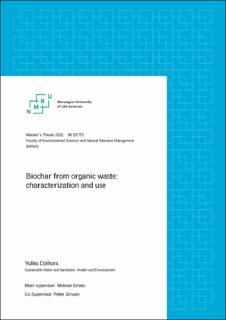| dc.description.abstract | Growing population, rapid urbanization, economic boost, and improved living standard have increased the demand for energy, water, food, and other resources. At the same time, the increase in population has resulted in a significant increase in organic and inorganic waste generation which caused increasing the risk of pollution and degradation of the natural environment and further limiting resource availability. The safe disposal and utilization of sewage sludge, in particular, become challenging because of the potential environmental risks posed by heavy metals and emerging contaminants found in the sludge. Moreover, it became more obvious that the current practices of the linear economy are not able to meet sustainably the growing demand of resources particularly for energy, water, and food for the rapidly growing population. Thus, the shift to the circular economy concept is gaining more interest as it has potential for sustainable development, which includes resource use efficiency, material recycling/upcycling, and cascade use, where all materials are at each stage of the process are considered to be valuable sources but not wastes.
Conversion of sewage sludge and waste wood biomass into biochars is a promising approach for sludge management from the circular economy and environmental protection perspective. Production of biochar from sludge or other organic wastes allows recovery of nutrients and energy, contributes to carbon sequestration, and reduces greenhouse gas emissions. However, due to the concerns related to the legal and strict regulation of its application, biochar should be properly characterized for different uses and functions. In this study the biochar from three different feedstocks 1) – Softwood pellets from whole tree trunks of 60% of Norwegian spruce and 40% of Scots pine (W); 2) – Waste sludge (Bio-rest) from Lindum/Vesar (WS1); and 3) –Waste sludge from Ullensaker (WS2) produced by microwave-assisted pyrolysis (MAP) with the same exposure time (20 mins), but with different pyrolysis temperatures in the range of 500 – 800 °C. The sequence of analyses includes pH, electrical conductivity, total, fixed, and volatile solids, moisture and ash content, bulk density, specific surface area, optical characterization (including Scanning Electron Microscopy (SEM), and X-ray Diffraction microscopy), elemental and chemical analyses including heavy metals. Additionally, the molar ratio of H:C, O:C, and (N+O)/C was calculated as aromaticity, hydrophilicity, and polarity index, respectively and the C/N ratio for nitrogen availability were used for characterization of the biochars and to identify possible biochar uses for different applications and functions.
This study demonstrates that the composition of the different feedstock results in different biochar characteristics when produced at similar temperatures and exposure time. The SEM and XRD showed the differences in the morphology and distribution of elements on the surface of the different biochars. Wood pellet biochar showed more C (about 93%) than Ullensaker sewage sludge (about 30%) and food waste sludge (about 15%). Wood biochar had more surface area (313 m2/g – 402 m2/g) than the two sludge-based biochars (77 m2/g – 122 m2/g). Moreover, H/C and O/C ratio for wood biochar is <0.7 and <0.2 which indicates more carbonized and more stable material than the sludge-based biochar which have, on contrary, higher values. Whereas, the nutrient, mineral, and heavy metal concentrations were higher for the two sludge-based biochar. Due to concerns of high Cu, Ni, and Zn from the food waste sludge and sewage sludge the biochar may not meet the requirements for agricultural applications but the biochar from these sources can be utilized for industrial applications (EBC-Material, Class IV) as valuable elements like P, TiO2 and others can be extracted. The biochar from wood pellet on the other hand can meet the EBC-AgriBio (Class I) requirements as feed or feed additives for animal husbandry. Characterization of biochar based on its source is therefore important to decide to which applications the biochar can be used. | en_US |

